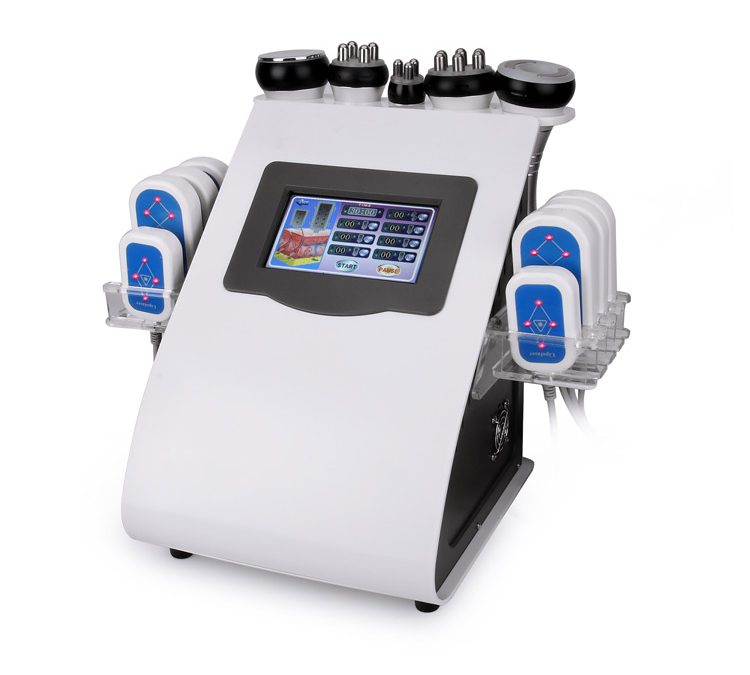Cavitation Slimming vacuum lipolaser Weight Loss Device JF040D
Ultrasonic EMS Facial Body Beauty Device SC017
40K Cavitation Ultrasonic Slimming Machine JF245C
Ultrasonic Cellulite Remover Fat Cavitation Machine JF645
3 in 1 Fat Cavitation Machine SC152
Velashape Cavitation Slimming Instrument JF254
EMS Stimulation Fat Burning Slimming Machine GN232
Muscle stimulation body sculpt Machine GN514B
Do you have unwanted fat in your body? Are you looking for a way of reducing it? If your answer is yes, then you should consider the option of ultrasonic cavitation.
Ultrasonic cavitation is a non-invasive fat reduction procedure that is ideal for those who want to reduce fat but are not ready for surgery.
Ultrasonic cavitation is a non-surgical method of body contouring that uses ultrasound technology to break down fat cells. The treatment is FDA-approved, and it is effective for patients who have not had success with maintaining a low-calorie balanced diet and exercise.
Ultrasound cavitation treatments are performed in a medical clinic or spa. The procedure takes about 30 minutes or more per treatment area, and patients typically receive multiple treatments over several weeks or months.
Ultrasound cavitation uses high-frequency sound waves to generate heat in fat cells, causing them to rupture and release their contents into the bloodstream.
Ultrasound cavitation is most effective when combined with other methods of weight loss such as dieting, exercise, and certain medications that suppress appetite.
This article provides an in-depth discussion on how ultrasonic cavitation works, how to prepare for ultrasonic cavitation, how long ultrasonic cavitation sessions last, which body parts are best for ultrasonic cavitation, the health impacts of ultrasonic cavitation, the pros and cons of using non-invasive methods of fat reduction, and if ultrasonic cavitation safe.
How does it work?
Ultrasonic cavitation is usually performed in a doctor’s office or medical spa. The procedure can take anywhere from 15 minutes to an hour depending on the size of the patient’s abdomen area being treated.
During the procedure, ultrasound gel is applied directly onto the patient’s skin before an ultrasound probe is placed over their stomach area (or other targeted areas). Once the ultrasound probe has been placed on the skin, it emits high-frequency sound waves that penetrate deep into fat cells causing them to rupture.
The body then naturally eliminates this broken-down fat through its normal bodily processes.
How to prepare for ultrasonic cavitation
To prepare for ultrasonic cavitation, you should:
1. Eat healthy foods and avoid junk food before your treatment
Eating a diet rich in fruits and vegetables will help your body detoxify after the procedure. You should also avoid eating any foods high in fat or sugar before your treatment because these types of foods can cause inflammation in your body.
2. Drink plenty of water before your treatment
Dehydration can lead to fatigue during treatment; being well-hydrated will help you feel energized throughout the procedure.
3. Avoid caffeine before your treatment
Taking caffeine can make you feel jittery during treatment. Caffeine interferes with your body’s ability to absorb nutrients from food; this means that if you consume caffeine without eating enough vitamins or minerals before your treatment, it could cause side effects such as nausea or dizziness during treatment.
4. Wear loose clothing
Wear something comfortable and easy to remove.
5. Don’t take aspirin
Stop taking aspirin, ibuprofen (Advil), or other blood thinners two weeks before your procedure. These medications can cause bleeding and bruising during Ultrasonic cavitation.
6. Don’t wear makeup
Don’t wear makeup on the day of your treatment. Avoid skin products with fragrances or oils, as they can compromise results.
7. Talk to your doctor about your allergies
Tell your doctor about any medical conditions or allergies you have, including recent surgeries or infections. Also, let him know if you’re pregnant or breastfeeding.
8. Go with your medications
Bring along any medications or supplements you regularly take, including any vitamins or supplements that contain iron or calcium. Your doctor may need to make special arrangements if you take certain medications regularly — such as birth control pills — because they could interfere with the procedure.
How long do ultrasonic cavitation sessions last?
Ultrasonic cavitation sessions last between 30 to 90 minutes, depending on the size of the area being treated. For example, if you’re having three areas of your body treated at once, each area will take 15 to 30 minutes to complete.
Ultrasonic cavitation sessions are typically performed once or twice a week for six weeks. You will start seeing the results of ultrasonic cavitation within six to twelve weeks.
Ultrasonic cavitation sessions are relatively quick and easy, so there’s no need to worry about scheduling an appointment that may take all day. You can also get back to your daily life quickly after treatment, which is another reason why this treatment is so popular.
Which body parts are best for ultrasonic cavitation?
The most common areas for ultrasonic cavitation are the abdomen, upper and lower back, thighs, and buttocks. Lipo cavitation Machine can also be used on the arms to improve their appearance.
Ultrasonic cavitation cannot be performed on the neck, head, and other bony regions of the body.
Health impacts of ultrasonic cavitation
Fat deposits in the body that may be difficult to lose with exercise alone are reduced by ultrasonic cavitation. However, this process cannot be employed as a stand-alone weight loss treatment. Cellulite and adipose tissue can be best reduced by ultrasonic cavitation. This decreases circumference and enhances body shape and contour.
After the cavitation operation, it’s crucial to keep up a low-calorie, balanced diet and get some exercise. This will aid in weight management and the treatment of ailments like prediabetes in obese women.
Women with abdominal obesity and people with stable Body Mass Index values (18.5k/m2 and 24.9kg/m2) are both candidates for ultrasonic cavitation therapy. The surgery shouldn’t be done on the people listed below:
Those who have previously had cancer.
Inflamed or infected area where the procedure will be performed.
Women who are pregnant and nursing
People with skinfolds that are less than two centimeters.
Those who suffer from severe illnesses like osteoporosis or diabetes.
People who have metal implants or cardiac pacemakers.
Individuals who take medications that alter blood clotting or have coagulation issues.
Ultrasonic cavitation is a secure method that the FDA has approved. There is no recovery time necessary because the process is non-invasive. Fat cells that have been killed cannot regrow. Ultrasonic cavitation effects can remain for a long time if you keep up your weight-maintenance routine.
Exercises such as physical therapy should not be substituted with ultrasonic cavitation. Exercise regularly is more effective at lowering body weight and the risk of cardiovascular disease.
Pros and cons of using non-invasive methods of fat reduction
Pros
1.No general anesthesia is required.
2. Little to no downtime.
3.No incisions or stitches are required.
4.No scarring or bruising.
5. Minimal discomfort during treatment.
6. A healthy lifestyle yields results that last for a very long time.
7. Mild side effects.
8. Results come slowly, allowing you to continue treating privately.
9. Many patients can resume normal activities immediately after treatment with no visible sign.
10. Ultrasonic cavitation also boosts collagen production in your skin, resulting in younger-looking skin.
11. Improving lymph flow.
Cons
1. Less weight reduction than with intrusive procedures like liposuction.
2. It May not be effective for people who need to shed a lot of weight.
3.For desired outcomes, it could be necessary to combine it with other weight-loss techniques.
4. It is impossible to calculate precisely how much fat was shed.
5. Following ultrasonic cavitation, you must keep up with a healthy, balanced diet and get enough fluids.
6. Consider consuming fewer carbohydrates and things with a low glycemic index as part of a reduced-calorie diet (e.g. fruits and vegetables).
7. The results are usually temporary because excess fat will eventually return unless diet and exercise habits change.
8. At the treatment spot, some patients may develop bruising, swelling, numbness, and pain. Following each treatment, they can also notice a little redness or discoloration in the treated area for a few days.
Is ultrasonic cavitation safe?
Ultrasound energy is considered safe by most doctors when used at low levels for therapeutic purposes, such as removing excess fat from an area of your body where it’s causing health problems such as cellulite or varicose veins. When used correctly, there should be no long-term effects on your internal organs or other parts of your body outside of the targeted area being treated with ultrasonic cavitation.
The most common side effects are temporary redness and swelling at the treatment site, which typically lasts less than 24 hours after treatment. You may also experience bruising or swelling in areas other than where the treatment was performed, so ensure you inform your doctor if you experience any unusual symptoms following ultrasonic cavitation treatments.
Also, if you’re considering getting ultrasonic cavitation treatment done at an aesthetic clinic or spa, make sure they have experience performing this kind of procedure on their staff and equipment. Your practitioner should also have access to medical equipment such as defibrillators in case an emergency arises during treatment.
Conclusion
Ultrasonic cavitation is a safe and effective non-surgical treatment that uses sound waves to treat skin conditions, such as cellulite, stretch marks, and scars. It’s also used to treat body contouring and weight loss.
Ultrasonic cavitation is a treatment for fat reduction that has been used for years. It’s a non-invasive, painless procedure that uses low-frequency sound waves to break up fat cells.
The procedure is done under local anesthesia and takes about an hour. Ultrasound waves are applied to the targeted area. The sound waves create tiny bubbles in the fat cells which collapse, breaking up the cell structure and causing it to be released from the body through the lymphatic system.
The procedure can be performed on any part of your body including the abdomen, thighs, arms, and buttocks. Because it’s non-invasive, there are no scars or downtime associated with this procedure.

